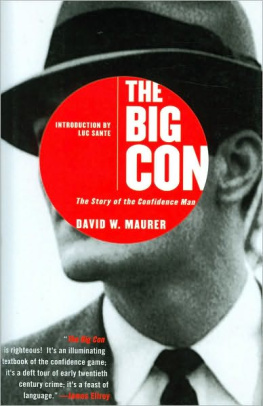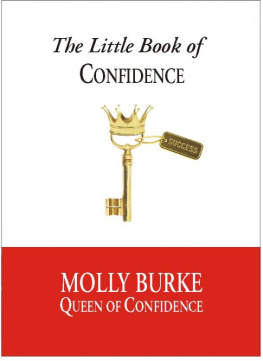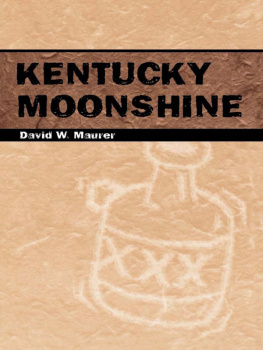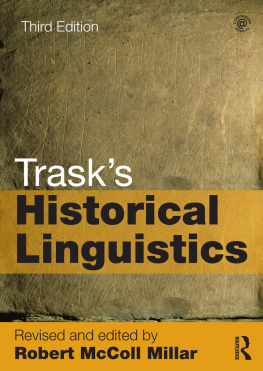David Maurer - The Big Con: The Story of the Confidence Man
Here you can read online David Maurer - The Big Con: The Story of the Confidence Man full text of the book (entire story) in english for free. Download pdf and epub, get meaning, cover and reviews about this ebook. year: 1940, publisher: Anchor Books, genre: Detective and thriller. Description of the work, (preface) as well as reviews are available. Best literature library LitArk.com created for fans of good reading and offers a wide selection of genres:
Romance novel
Science fiction
Adventure
Detective
Science
History
Home and family
Prose
Art
Politics
Computer
Non-fiction
Religion
Business
Children
Humor
Choose a favorite category and find really read worthwhile books. Enjoy immersion in the world of imagination, feel the emotions of the characters or learn something new for yourself, make an fascinating discovery.
- Book:The Big Con: The Story of the Confidence Man
- Author:
- Publisher:Anchor Books
- Genre:
- Year:1940
- Rating:5 / 5
- Favourites:Add to favourites
- Your mark:
- 100
- 1
- 2
- 3
- 4
- 5
The Big Con: The Story of the Confidence Man: summary, description and annotation
We offer to read an annotation, description, summary or preface (depends on what the author of the book "The Big Con: The Story of the Confidence Man" wrote himself). If you haven't found the necessary information about the book — write in the comments, we will try to find it.
The Big Con: The Story of the Confidence Man — read online for free the complete book (whole text) full work
Below is the text of the book, divided by pages. System saving the place of the last page read, allows you to conveniently read the book "The Big Con: The Story of the Confidence Man" online for free, without having to search again every time where you left off. Put a bookmark, and you can go to the page where you finished reading at any time.
Font size:
Interval:
Bookmark:
This book made available by the Internet Archive.





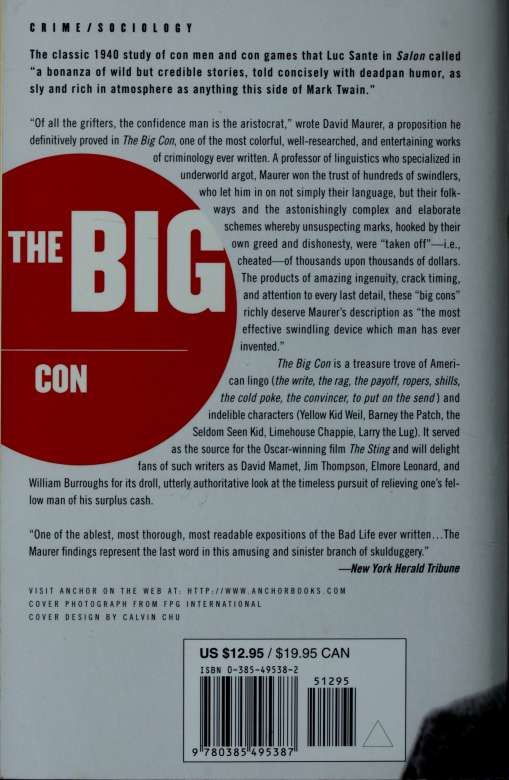
Luc Sante
Introduction to the Anchor Edition
The book you are holding in your hands, now reprinted after a shamefully long hiatus, is, like its subjects, crowned with many hats. Its origins are in linguistics; it is nominally a work of criminology; it has blood ties to folklore; it falls within the scope of Americana; it serves up a parcel of social history; and of course it is a robust and spring-heeled piece of literature. Swindling is a literary subject that must go back to Egyptian and Mesopotamian antecedents, certainly to Reynard the Fox by way of the Elizabethan coney-catchers and the Spanish picaresque. In American culture it looms as one of the major themes, along with self-invention and going on the lam, which are not unrelated. Edgar Allan Poe put it conclusively:
A crow thieves; a fox cheats; a weasel outwits; a man diddles. To diddle is his destiny. "Man was made to mourn/' says the poet. But not so:he was made to
diddle. This is his aimhis objecthis end. And for this reason when a man's diddled we say he's "done. "
The Big Con can also be considered a piece of art criticism, since it is not just any taxonomy of styles in diddling, but a refined appreciation of the high swindle, the confidence game in its Augustan Age.
David Maurer was a linguist, eventually professor emeritus of linguistics at the University of Louisville. He began his publishing career in 1930 with Speech Peculiarities of the North American Fisherman and not long after began his lifelong study of criminal and demimonde dialects. His other books include Whiz Mob: A Correlation of the Technical Argot of Pickpockets with Their Behavior Pattern (1955), Narcotics and Narcotic Addiction (1973), The American Confidence Man (a more scientific enlargement of the present book; 1974), Kentucky Moonshine (1974), and the posthumously published omnibus volume Language of the Underworld (1981). He was one of the editors of H. L. Mencken's The American Language in its single-volume format, and he contributed the entry on "Slang" to at least one edition of the Encyclopaedia Britannica. His correspondents included fellow language addicts such as S. J. Perelman, and an enormous number of denizens of the underworld, both behind bars and at large. When Prudence Crowther, editor of Perelman's letters, sought out his end of their exchange, she discovered that Maurer had requested in his will that his entire archive be destroyed upon his death, for fear of compromising his pen pals pursued by the law. Maurer, as this book will amply demonstrate, earned the intimate confidence of many vulnerable and close-mouthed miscreants, people who would not have opened up to journalists. The kind of fieldwork he engaged in, as the linguist Stuart Berg Flexner, a former student of Maurer's, pointed out, "takes a great deal of physical stamina and a strong per
sonality, as well as mental ability." It didn't hurt that "Maurer is big, with large shoulders and strong arms and hands, a man who can help pull in a heavy fishing net in freezing weather or push a car out of a muddy backroad on the way to an illegal still." He was also, quite evidently, blessed with a considerable sense of humor.
Maurer studied the lingo ofamong otherscarnies, junkies, safe-crackers, forgers, pot smokers, faro-bank players, shell-game hustlers, race-track touts, pickpockets, moonshiners, prostitutes, and pimps, but his interest in the language of the confidence men was a case apart. More than any other of the dialects of the American underworld, it approached the comprehensiveness of French argot or Australian rhyming slang. It is one of the peculiarities of all American subcultural lingos that they focus solely on technical terms or other weighted topicsthere are invariably words for sex, death, and money, but not for table, door, or window. Grifter slang is more complex by virtue of covering a more complex subject, with an enormous range of situations, nuances, and subtleties that find no equivalent in the language of circuses or dice games or heroin traffic. To study the lingo of the con is inevitably to study the con itself, since a term such as "cackle-bladder" or "shut-out" cannot be properly defined without giving a full account of its use, and such an account cannot be illustrated with stick figures. That is why this book stands alone in Maurer's oeuvre: Whereas it is possible to map out the generic behavior of pickpockets, tracing patterns and supplying copious examples without necessarily referring to individuals, confidence men are after all artists, laden with idiosyncrasies that distinguish their work. There are styles, schools, trends, evolutions, innovations, reactions, triumphs, failures. And it takes much more than cupidity and unscrupulous-ness to make a con artist. The best possess a combination of superior intelligence, broad general knowledge, acting
x INTRODUCTION TO THE ANCHOR EDITION
ability, resourcefulness, physical vigor, and improvisa-tional skills that would have propelled them to the top of any profession. The big con would be poorly served by entomology; it demands narrative.
Poe, in "Diddling/' provides a list of necessary characteristics of the swindler: "minuteness, interest, perseverance, ingenuity, audacity, nonchalance, originality, impertinence, and grin." They are items needed for the short con as well as the long or big. But while any practitioner of the big con can play the smack, the tat, or the wipe, the reverse does not obtain. The big con is the game of an elite; to Poe's list must be added ambition, endurance, rigor, concentration, organization, compartmental-ization, persuasiveness, and ironclad self-confidence. If the short con is an anecdote, the long con is a novel. Essentially, a short con involves taking the pigeon for all the money he has on his person, while the big con sends him home to get more. What all confidence games have in common is that they employ the victim's greed as a lever. The most primitivethe gold brick, which is supposed to be literal, or the green goods, which is a machine alleged to crank out banknotesoperate on the same basic principle as the most elaborate rigs involving intercontinental travel, multiple furnished sets, and dozens of carefully rehearsed extras. In all of them the mark is induced to participate in an extralegal moneymaking scheme that requires an investment. The cruder mechanisms are simple bait-and-switch devicesthe wipe, for example, in which a rustic or an immigrant is invited to pool his resources with the sharper and deposit the total as security against a lost-wallet rakeoff or something similar, continues to figure in the press at intervals to this very day. In the most sophisticated cons, however, the doe may ever after remain unaware that he has been bilked, merely registering the affair as a gambit that failed.
That last, Cheshire-cat item in Poe's list merits attention. Humor is never very far from the heart of the con. After all, garden-variety swindles from shortchanging to fortune-telling to patent-medicine manufacture are merely theft without a weapon. The con, however, which hoists the victim by his own petard, combines formal elegance, careful imitation of legitimate enterprise, and rough justice into what can only be called parody. The subgenre called the rag, for example, involving as it does a pretense of stock manipulation, attracts the sorts of birds who would be drawn to actual stock manipulation and skins them alone, thus producing a far lesser loss to society than the swindles engaged in by ostensibly respectable sorts. The big con can also be considered as a form of theater, very nearly a Gesamtkunstwerk, staged with minute naturalistic illusionism for an audience of one, who is moreover enlisted as part of the cast. The con game always has at least two principals, the roper and the inside man, whose roles are as archetypal as Punch and Judy, or Mr. Tambo and Mr. Bones in minstrelsy. They bounce the victim between them the way cops in a Mutt-and-Jeff torture team manipulate a suspect; it is a kind of three-man tango. Then there are two sorts of settings: available real-life items, such as restaurants and hotel rooms, which might verbally be given imaginary properties but are otherwise unaltered, and outfits completely rigged up, empty offices or storefronts made over into bookie joints, brokers' suites, or high-end gambling clubs. A scheme might require one or more of these, furnished down to carpets, ashtrays, and spittoons, with crowds of several dozen currently unemployed con men acting as shills, fronts, or mere bodies, at the center of it a manager who is both acting the part of a manager and actually managing the outfit. And such a production must be called into being on very short notice.
Next pageFont size:
Interval:
Bookmark:
Similar books «The Big Con: The Story of the Confidence Man»
Look at similar books to The Big Con: The Story of the Confidence Man. We have selected literature similar in name and meaning in the hope of providing readers with more options to find new, interesting, not yet read works.
Discussion, reviews of the book The Big Con: The Story of the Confidence Man and just readers' own opinions. Leave your comments, write what you think about the work, its meaning or the main characters. Specify what exactly you liked and what you didn't like, and why you think so.

